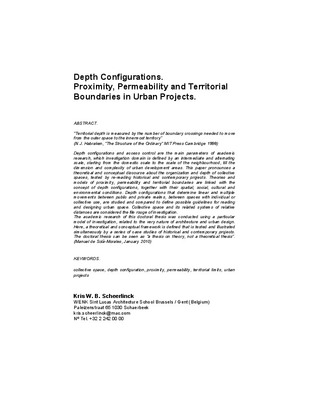JavaScript is disabled for your browser. Some features of this site may not work without it.
Buscar en RiuNet
Listar
Mi cuenta
Estadísticas
Ayuda RiuNet
Admin. UPV
Depth Configurations. Proximity, Permeability and Territorial Boundaries in Urban Projects
Mostrar el registro sencillo del ítem
Ficheros en el ítem
| dc.contributor.author | Scheerlinck, Kris W. B.
|
es_ES |
| dc.date.accessioned | 2012-03-14T00:19:52Z | |
| dc.date.available | 2012-03-14T00:19:52Z | |
| dc.date.issued | 2012-03-14 | |
| dc.identifier.isbn | 978-84-938670-5-8 | |
| dc.identifier.uri | http://hdl.handle.net/10251/15036 | |
| dc.description | Ponencia escrita presentada en la sesión dedicada a Ámbitos, Innovación y Calidad, en las IV Jornadas Internacionales sobre Investigación en Arquitectura y Urbanismo. | es_ES |
| dc.description.abstract | "Territorial depth is measured by the number of boundary crossings needed to move from the outer space to the innermost territory" (N.J. Habraken, "The Structure of the Ordinary" MIT Press Cambridge 1998) Depth configurations and access control are the main parameters of academic research, which investigation domain is defined by an intermediate and alternating scale, starting from the domestic scale to the scale of the neighbourhood, till the dimension and complexity of urban development areas. This paper pronounces a theoretical and conceptual discourse about the organization and depth of collective spaces, tested by re-reading historical and contemporary projects. Theories and models of proximity, permeability and territorial boundaries are linked with the concept of depth configurations, together with their spatial, social, cultural and environmental conditions. Depth configurations that determine linear and multiple movements between public and private realms, between spaces with individual or collective use, are studied and compared to define possible guidelines for reading and designing urban space. Collective space and its related systems of relative distances are considered the file rouge of investigation. The academic research of this doctoral thesis was conducted using a particular model of investigation, related to the very nature of architecture and urban design. Here, a theoretical and conceptual framework is defined that is tested and illustrated simultaneously by a series of case studies of historical and contemporary projects. The doctoral thesis can be seen as "a thesis on theory, not a theoretical thesis". (Manuel de Solà-Morales, January 2010) | es_ES |
| dc.language | Inglés | es_ES |
| dc.publisher | Universitat Politècnica de València | es_ES |
| dc.relation.ispartof | 4IAU 4ª Jornadas Internacionales sobre Investigación en Arquitectura y Urbanismo, Valencia, 2011 | es_ES |
| dc.rights | Reserva de todos los derechos | es_ES |
| dc.subject | Collective space | es_ES |
| dc.subject | Depth configuration | es_ES |
| dc.subject | Proximity | es_ES |
| dc.subject | Permeability | es_ES |
| dc.subject | Territorial limits | es_ES |
| dc.subject | Urban projects | es_ES |
| dc.title | Depth Configurations. Proximity, Permeability and Territorial Boundaries in Urban Projects | es_ES |
| dc.title.alternative | Configuraciones de Profundidad. Proximidad, Permeabilidad y Límites Territoriales en Proyectos Urbanos. | es_ES |
| dc.type | Comunicación en congreso | es_ES |
| dc.rights.accessRights | Abierto | es_ES |
| dc.description.bibliographicCitation | Scheerlinck, KWB. (2012). Depth Configurations. Proximity, Permeability and Territorial Boundaries in Urban Projects. http://hdl.handle.net/10251/15036 | es_ES |
| dc.relation.conferencename | 4IAU 4ª Jornadas Internacionales sobre Investigación en Arquitectura y Urbanismo | es_ES |
| dc.relation.conferencedate | 2011 | es_ES |
| dc.relation.conferenceplace | Valencia | es_ES |






